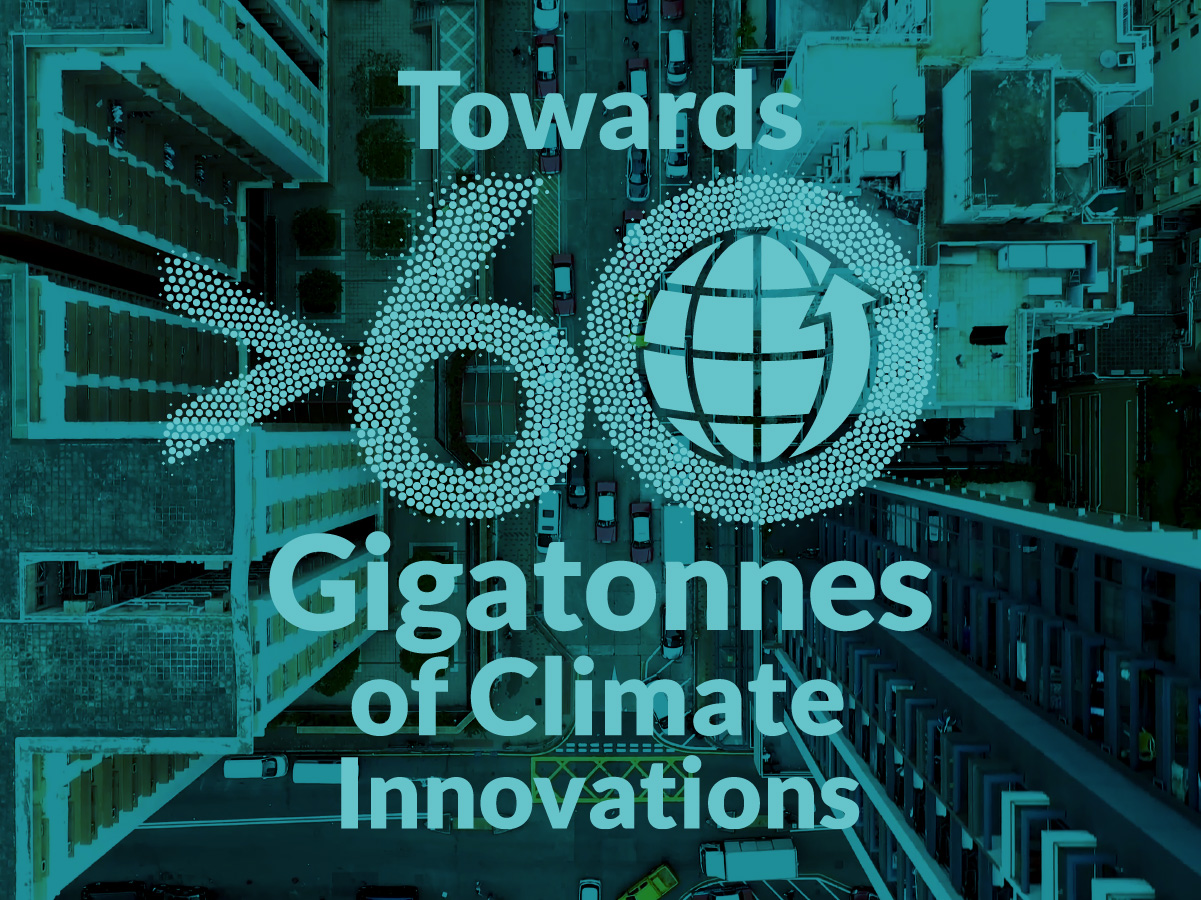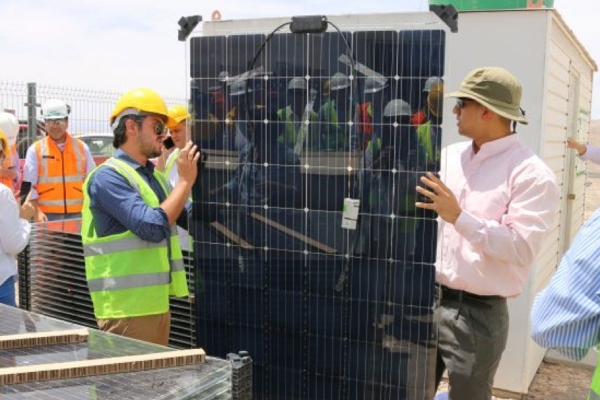Nominated innovations
1000 innovative clean energy solutions and > 150 framework enablers with the potential to deliver more than twelve gigatonnes of avoided emissions by 2030
These assessments are based on a basic avoided emission assessment. The overall concept of avoided emissions is that a solution (product or service) enables the same function to be performed with significantly less GHG emissions. The method of measuring avoided emissions, is to compare a baseline scenario without the enabling solution, with a scenario using the enabling solution; whereby the baseline represents the ‘business as usual’ (BAU) scenario.
These assessments are based on the framework document: The Avoided Emissions Framework (AEF) from September 2020

Solar photovoltaic stove with batteries
Solar PV-based cooking solution.
India

SoULS Laboratory, IIT Bombay
Solar photovoltaic stove with batteries
Solar PV-based cooking solution.
Currently unavailable

Solar module recycling
R-Solar wrote: For solar panel manufacturers who are looking for a way to deal with their disposed and defected solar modules we have developed a process and technology that allows different module components to be recovered, recycled and reused as-raw materials in manufacturing... Source: EIT Climate KIC's ClimateLaunchPad
Lithuania

R-Solar
Solar module recycling
R-Solar wrote: For solar panel manufacturers who are looking for a way to deal with their disposed and defected solar modules we have developed a process and technology that allows different module components to be recovered, recycled and reused as-raw materials in manufacturing... Source: EIT Climate KIC's ClimateLaunchPad
Currently unavailable

Solar master map for Dhaka city
Solar Master Map wrote: Bangladesh is set to face a major challenge with the exhaustion of natural gas sources being predicted to be as soon as 2025. The government is therefore trying to shift to alternate sources of energy. Solar irradiation absorbed in bangladesh is about 4-6(kwh/m2/day) and sunshine amounts to 2,500 hours per year. Yet, we see that most rooftops in the dhaka city has not installed solar panels despite the government incentives. Our solution focuses on addressing this major challenge with a participatory planning approach. We want to make solar potential maps using remote sensing and geographic information systems... Source: EIT Climate KIC's Climathon
Bangladesh

Solar Master Map
Solar master map for Dhaka city
Solar Master Map wrote: Bangladesh is set to face a major challenge with the exhaustion of natural gas sources being predicted to be as soon as 2025. The government is therefore trying to shift to alternate sources of energy. Solar irradiation absorbed in bangladesh is about 4-6(kwh/m2/day) and sunshine amounts to 2,500 hours per year. Yet, we see that most rooftops in the dhaka city has not installed solar panels despite the government incentives. Our solution focuses on addressing this major challenge with a participatory planning approach. We want to make solar potential maps using remote sensing and geographic information systems... Source: EIT Climate KIC's Climathon
Currently unavailable

Solar Lake
H2O wrote: Using water harvesting methods to create an artificial lake and facilitating the distribution of water to nearby farms and communities through the use of solar pv pumps.. Source: EIT Climate KIC's Climathon
Sudan

H2O
Solar Lake
H2O wrote: Using water harvesting methods to create an artificial lake and facilitating the distribution of water to nearby farms and communities through the use of solar pv pumps.. Source: EIT Climate KIC's Climathon
Currently unavailable

Solar Fruits
Solar Fruits wrote: At modern terra we mimic temperate climate and conditions by utilizing our plentiful sunlight and wind resources to grow crops that normally wouldn’t grow in the tropics. This will to help ensure food security of small island developing states in disaster prone regions. Modern terra’s implementation will also aid in reducing high food import bills and carbon emissions from shipping to remote sids. To guarantee the aforementioned, modern terra will also be an educational and equipment resource for local farmers to start their own modern farms... Source: EIT Climate KIC's ClimateLaunchPad
Barbados

Solar Fruits
Solar Fruits
Solar Fruits wrote: At modern terra we mimic temperate climate and conditions by utilizing our plentiful sunlight and wind resources to grow crops that normally wouldn’t grow in the tropics. This will to help ensure food security of small island developing states in disaster prone regions. Modern terra’s implementation will also aid in reducing high food import bills and carbon emissions from shipping to remote sids. To guarantee the aforementioned, modern terra will also be an educational and equipment resource for local farmers to start their own modern farms... Source: EIT Climate KIC's ClimateLaunchPad
Currently unavailable

Solar energy harvesting in Chile's desert
The Atacama Desert, located in northern part of Chile, has special conditions that need the development of technologies to allow an efficient solar energy generation. The area presents an average direct global radiation level of 3.500 kWh/m² per annum and an horizontal global radiation level of 2.500 kWh/m² per annum, one of the highest in the world. The solution is a new optimal solar technology to be used in the Atacama Desert. The development includes new materials to resist high radiation levels, a bifacial photovoltaic panel to take advantage of the radiation and the ground and new methods for operation and maintenance considering the lack of water in the desert.
Chile

AtaMos-TeC
Solar energy harvesting in Chile's desert
The Atacama Desert, located in northern part of Chile, has special conditions that need the development of technologies to allow an efficient solar energy generation. The area presents an average direct global radiation level of 3.500 kWh/m² per annum and an horizontal global radiation level of 2.500 kWh/m² per annum, one of the highest in the world. The solution is a new optimal solar technology to be used in the Atacama Desert. The development includes new materials to resist high radiation levels, a bifacial photovoltaic panel to take advantage of the radiation and the ground and new methods for operation and maintenance considering the lack of water in the desert.
Currently unavailable

Solar concentrators for high-rise buildings
Un1imited wrote: Global concern about electrical consumption and environmental sustainability inspired the application of solar energy in buildings. As expected, more than 60% of the world’s population will live in urban areas in 2030. Residential buildings are being built to be increasingly taller. At present, rooftops are typically used to install pv systems, however, as buildings are becoming taller, the available roof space per living unit may not be adequate to meet the energy demand of the building. On the other hand, many high-rise residential buildings have a large façade-to-roof area ratio. Building facades could therefore potentially be used for harvesting solar energy... Source: EIT Climate KIC's ClimateLaunchPad
United Kingdom

Un1imited
Solar concentrators for high-rise buildings
Un1imited wrote: Global concern about electrical consumption and environmental sustainability inspired the application of solar energy in buildings. As expected, more than 60% of the world’s population will live in urban areas in 2030. Residential buildings are being built to be increasingly taller. At present, rooftops are typically used to install pv systems, however, as buildings are becoming taller, the available roof space per living unit may not be adequate to meet the energy demand of the building. On the other hand, many high-rise residential buildings have a large façade-to-roof area ratio. Building facades could therefore potentially be used for harvesting solar energy... Source: EIT Climate KIC's ClimateLaunchPad
Currently unavailable

Solar concentrator thermal stove with heat storage
The solution consists of a solar-based indoor stove. The stove is innovative because it is meant to be used in-doors. This could have many positive effects from less environmental impact to reducing the human health impacts from traditional means of indoor cooking.
India

National Institute of Technology Kurukshetra, Haryana
Solar concentrator thermal stove with heat storage
The solution consists of a solar-based indoor stove. The stove is innovative because it is meant to be used in-doors. This could have many positive effects from less environmental impact to reducing the human health impacts from traditional means of indoor cooking.
Currently unavailable

Solar concentrated power systems
Heliopulse wrote: We make solar concentrated power systems for households. Our system has many benefits: . -it doesn’t overheat in summer, . -it works effectively in winter, . -it tracks the sun, . -it has a short pay-back period. And, what is most important,. - it is 2 times more efficient than any other solar collectors systems. We are the first, who made a concentrated solar power system for households and individual use... Source: EIT Climate KIC's ClimateLaunchPad
Ukraine

Heliopulse
Solar concentrated power systems
Heliopulse wrote: We make solar concentrated power systems for households. Our system has many benefits: . -it doesn’t overheat in summer, . -it works effectively in winter, . -it tracks the sun, . -it has a short pay-back period. And, what is most important,. - it is 2 times more efficient than any other solar collectors systems. We are the first, who made a concentrated solar power system for households and individual use... Source: EIT Climate KIC's ClimateLaunchPad
Currently unavailable

SoilSpy
SoilSpy wrote: Soilspy facilitates farmers to monitor environmental parameters and analyse the concentration of multiple specific nutrients precisely, quickly, cost efficiently, and directly on field. Through optimized fertilization according to the analyzed nutrient levels and therefore needs of the plants, yield can be maximized while minimizing the usage and cost of fertilizer and sustainably reducing the pollution of ground water... Source: EIT Climate KIC's ClimateLaunchPad
Germany

SoilSpy
SoilSpy
SoilSpy wrote: Soilspy facilitates farmers to monitor environmental parameters and analyse the concentration of multiple specific nutrients precisely, quickly, cost efficiently, and directly on field. Through optimized fertilization according to the analyzed nutrient levels and therefore needs of the plants, yield can be maximized while minimizing the usage and cost of fertilizer and sustainably reducing the pollution of ground water... Source: EIT Climate KIC's ClimateLaunchPad
Currently unavailable